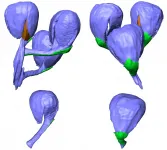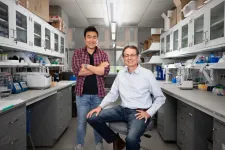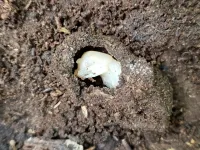Brain tumors caused by normal neuron activity in mice predisposed to such tumors
Light triggers formation, feeds growth of optic nerve tumors
2021-05-26
(Press-News.org) Seeing, hearing, thinking, daydreaming -- doing anything at all, in fact -- activates neurons in the brain. But for people predisposed to developing brain tumors, the ordinary buzzing of their brains could be a problem. A study by researchers at Washington University School of Medicine in St. Louis and Stanford University School of Medicine shows that the normal day-to-day activity of neurons can drive the formation and growth of brain tumors.
The researchers studied mice genetically prone to developing tumors of their optic nerves, the bundle of neurons that carries visual signals from the eyes to the brain. The mice served as a model for children with the genetic condition neurofibromatosis type 1 (NF1). About one in six children with NF1 develops low-grade optic nerve tumors by age 7. In this study, mice with Nf1 mutations raised under normal lighting developed tumors; those kept in the dark during a critical period of development did not.
The findings, published May 26 in the journal Nature, suggest that neuronal activity plays an underappreciated role in nervous system cancers. The research opens up new avenues to preventing brain tumors in children at high risk for them.
"Optic gliomas are very common in children with NF1, and they can cause vision loss," said co-senior author David H. Gutmann, MD, PhD, the Donald O. Schnuck Family Professor of Neurology at Washington University and the director of the university's NF Center. "We don't have a good way to predict who will develop tumors or any way to prevent them. But now that we know these brain tumors are caused by exposure to light and neuronal activity, we can start thinking of next-gen prevention strategies. Maybe we can give kids cool sunglasses to wear with filters or lenses to block out certain wavelengths of light, or repurpose drugs that suppress excessive neuronal activity, and protect these kids from developing brain tumors and losing their sight."
Co-senior author Michelle Monje, MD, PhD, an associate professor of neurology at Stanford Medicine, previously demonstrated that neuronal activity drives the growth of an aggressive form of brain cancer. But it wasn't clear whether neuronal activity itself sets in motion the process of tumor formation or if it only bolsters the growth of tumors initiated by other processes.
As part of this study, the researchers used mice with mutations in their Nf1 gene. Such mice start developing low-grade tumors of their optic nerves around 9 weeks of age, and virtually all have tumors by 12 weeks to 16 weeks old. Since the neurons in the optic nerve become active when exposed to light, the researchers investigated whether they could reduce neuronal activity -- and, thereby, tumor formation -- simply by keeping the mice away from light. They raised mice from age 9 weeks to 16 weeks in the dark and then checked for tumors.
"The results were so striking. Mice raised in the dark simply did not develop tumors, while all the mice raised in the light did, despite their identical genetic predisposition to develop optic nerve tumors," Monje said. "While we had previously found that neuronal activity is an important regulator of glioma growth, these findings showed how crucial neuronal activity can be for tumor formation."
Further experiments verified the crucial role of light exposure and narrowed down the critical window to age 6 weeks to 12 weeks. None of the mice reared in the dark during that time frame developed tumors by 24 weeks of age. Putting mice older than 12 weeks, when the tumors already had formed, into darkness slowed tumor growth but did not shrink them.
First author Pan Yuan, PhD, who first worked with Gutmann at Washington University and is now a postdoctoral researcher with Monje, showed that the link between light and tumors requires a protein called neuroligin 3. When their optic nerves are stimulated, mice with Nf1 mutations release abnormally high levels of neuroligin 3. Blocking the protein with a drug or genetically modifying mice to eliminate the neuroligin 3 gene resulted in fewer and smaller tumors.
Moreover, brain tumors from people are also high in neuroligin 3, which suggests the possibility of targeting the protein as a treatment for brain tumors. The researchers analyzed tissue samples from 19 people with low-grade brain tumors and found high levels of neuroligin 3, regardless of whether they arose in children with NF1 or not.
"All of this is teaching us that we may have ignored one really important cell type in nervous system cancers: the neuron," Gutmann said. "As neurologists, we have been treating overactive neurons for decades with drugs. One of the directions our laboratories are pursuing is repurposing some of those drugs to see if we can shut off unwanted activity, maybe just for a short developmental period, and prevent brain tumors from forming. And there are other points at which we could intervene as well: by limiting light exposure, by targeting neuroligin 3 or inhibiting some other step in the pathway. It has really opened our eyes."
INFORMATION:
ELSE PRESS RELEASES FROM THIS DATE:
2021-05-26
What The Study Did: Researchers quantified the added burden of fatal opioid overdoses occurring in Ontario, Canada, during the first six months of the COVID-19 pandemic.
Authors: Tara Gomes, Ph.D., of the Keenan Research Centre of the Li Ka Shing Knowledge Institute, St. Michael's Hospital in Toronto, is the corresponding author.
To access the embargoed study: Visit our For The Media website at this link https://media.jamanetwork.com/
(doi:10.1001/jamanetworkopen.2021.12865)
Editor's Note: The article includes conflict of interest and funding support disclosures. ...
2021-05-26
What The Study Did: Researchers compared reporting practices for race, sex and socioeconomic status in randomized clinical trials published in general medical journals in 2015 with those published in 2019.
Authors: Asad Siddiqui, M.D., of the Hospital for Sick Children in Toronto, is the corresponding author.
To access the embargoed study: Visit our For The Media website at this link https://media.jamanetwork.com/
(doi:10.1001/jamanetworkopen.2021.11516)
Editor's Note: Please see the article for additional information, including other authors, author contributions and affiliations, conflict of interest and financial disclosures, and funding and support.
INFORMATION:
Media advisory: The full study is linked to this news ...
2021-05-26
Flowering plants (angiosperms) dominate most terrestrial ecosystems, providing the bulk of human food. However, their origin has been a mystery since the earliest days of evolutionary thought.
Angiosperm flowers are hugely diverse. The key to clarifying the origin of flowers and how angiosperms might be related to other kinds of plants is understanding the evolution of the parts of the flower, especially angiosperm seeds and the fruits in which the seeds develop.
Fossil seed-bearing structures preserved in a newly discovered Early Cretaceous silicified peat in Inner Mongolia, China, provide a partial answer to the origin of flowering plants, according to a study led by Prof. SHI Gongle from the Nanjing ...
2021-05-26
LEXINGTON, Ky. (May 26, 2021) - Using novel imaging methods for studying brain metabolism, University of Kentucky researchers have identified the reservoir for a necessary sugar in the brain. Glycogen serves as a storage depot for the sugar glucose. The laboratories of Ramon Sun, Ph.D., assistant professor of neuroscience, Markey Cancer Center at the University of Kentucky College of Medicine, and Matthew Gentry, Ph.D., professor of molecular and cellular biochemistry and director of the Lafora Epilepsy Cure Initiative at the University of Kentucky College ...
2021-05-26
Berkeley -- The lifestyle of the horned passalus beetle, commonly known as the bessbug or betsy beetle, might seem downright disgusting to the average human: Not only does this shiny black beetle eat its own poop, known as frass, but it uses its feces to line the walls of its living space and to help build protective chambers around its developing young.
Gross as it may seem, a new study suggests that this beetle's frass habits are actually part of a clever strategy for protecting the insect's health -- and could help inform human medicine, too.
Researchers at the University of California, Berkeley, have discovered that the frass of the horned passalus beetle is teeming with antibiotic and antifungal chemicals similar to the ones that humans use to ward off bacterial and ...
2021-05-26
In a new study published online in spring 2021 and in the July issue of the journal Contraception, University of Chicago Medicine investigators and colleagues interviewed primary care providers in Illinois about their interest in providing medication abortion care and found that lifting FDA restrictions on mifepristone to allow pharmacy dispensing could normalize medication abortion, facilitate its use in primary care facilities, and address disparities in reproductive health access.
"Mifepristone is used in combination with misoprostol to end early pregnancies, during the first trimester," ...
2021-05-26
COLUMBUS, Ohio - Thermoelectric power generators that make electrical power from waste heat would be a useful tool to reduce greenhouse gas emissions if it weren't for a most vexing problem: the need to make electrical contacts to their hot side, which is often just too hot for materials that can generate a current.
The heat causes devices to fail over time.
Devices known as transverse thermoelectrics avoid this problem by producing a current that runs perpendicular to the conducting device, requiring contacts only on the cold end of the generator. Though considered a promising ...
2021-05-26
DURHAM, N.H.--Researchers at the University of New Hampshire have conducted two of the first studies in New England to collectively show that toxic man-made chemicals called PFAS (per-and polyfluoroalkyl substances), found in everything from rugs to product packaging, end up in the environment differently after being processed through wastewater treatment facilities--making it more challenging to set acceptable screening levels.
"PFAS are persistent substances that are not easily broken down and have been linked to adverse health effects," said Paula Mouser, associate professor of civil and environmental engineering. "They are found in a wide variety of industrial, commercial and medicinal products and can end up in the body, human waste and the environment. If not managed correctly, they ...
2021-05-26
In a new study, scientists at The Hong Kong University of Science and Technology (HKUST) have revealed that most T cell epitopes known to be targeted upon natural infection are seemingly unaffected by current SARS-CoV-2 variants.
In their latest research, the team compiled and analysed data from 18 immunological studies of T cell responses involving over 850 recovered COVID-19 patients from across four continents who are well-distributed in age, gender, disease severity and blood collection time. They demonstrated that T cells in these patients targeted fragments (epitopes) of almost all of ...
2021-05-26
Rough night of sleep? Relying on caffeine to get you through the day isn't always the answer, says a new study from Michigan State University.
Researchers from MSU's Sleep and Learning Lab, led by psychology associate professor Kimberly Fenn, assessed how effective caffeine was in counteracting the negative effects of sleep deprivation on cognition. As it turns out, caffeine can only get you so far.
The study -- published in the most recent edition of Journal of Experimental Psychology: Learning, Memory, & Cognition -- assessed the impact of caffeine after a night of sleep deprivation. More than 275 participants were asked to complete a ...
LAST 30 PRESS RELEASES:
[Press-News.org] Brain tumors caused by normal neuron activity in mice predisposed to such tumors
Light triggers formation, feeds growth of optic nerve tumors




